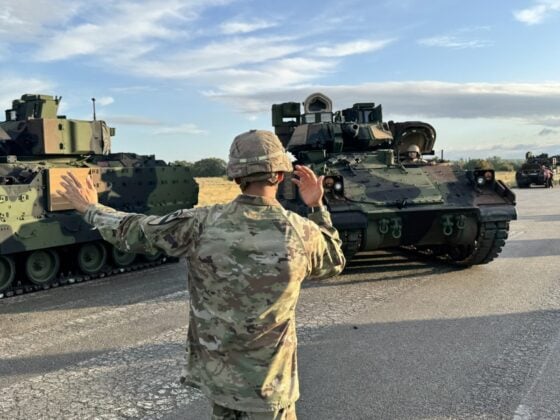
More than 100 M2A3 Bradley Fighting Vehicles are heading to Poland as the U.S. Army ramps up its latest rotational deployment in support of European allies.
The 1st Cavalry Division is providing troops from the 3rd Brigade Combat Team’s 2nd Battalion, 7th Cavalry Regiment for the mission, while logistics units across Europe have prepared the armored vehicles for immediate use.
The vehicles were drawn from U.S. Army prepositioned stocks in Germany and delivered in full mission-capable condition thanks to months of preparation by the 405th Army Field Support Brigade (AFSB) and Theater Logistics Support Center-Europe (TLSC-E). Nearly three dozen Bradleys were issued at the Coleman Army Prepositioned Stocks-2 (APS-2) site in Mannheim, while the rest came from maintenance activities in Kaiserslautern and Vilseck.
“We’ve been briefing U.S. Army Sustainment Command and U.S. Army Europe and Africa weekly on the status of these Bradleys since last August,” said Maj. Alec Velasco, executive officer at AFSBn-Germany. “Between the Army civilians, the green suitors, and the contractors who do 90 percent of the heavy lifting, it’s been a huge collaborative effort.”
Velasco explained that the effort to bring the vehicles up to full readiness was initially slow. “Progress was slow at first as we did the required technical inspections and ordered all the necessary parts,” he said. “As one system came up, we’d run the required tests and often find more problems. But we kept at it, and progress really accelerated this past spring and summer.”
The M2A3 Bradley is a tracked infantry fighting vehicle designed to transport soldiers while providing fire support on the battlefield. Armed with a 25mm Bushmaster cannon, TOW missile launcher, and 7.62mm coaxial machine gun, it delivers both firepower and mobility. It also features optics and communications systems that enhance its battlefield awareness and integration.
“I’ve never seen Bradleys like this,” said Staff Sgt. Josue Betancourt, a Bradley system maintainer supporting the battalion. “It’s the first time I’ve seen Bradleys in this condition my entire 10-year career, to be honest with you.”
According to the Army, the rotational force model reduces the need to deploy armored vehicles from the United States, saving time and wear on the fleet. The Coleman APS-2 site is one of six such facilities across Europe managed by the 405th AFSB, providing what the Army describes as “turn-key power projection packages” that are ready to support missions at short notice.
“Coming over here and falling in on this equipment … is hugely beneficial for us,” said 1st Lt. Robert Zelinski, a platoon leader in B Company, 2nd Battalion. “All we have to do is maintain the APS equipment and then give it back to the 405th AFSB when we’re done.”
1st Lt. Reece Crook, executive officer of the same unit, echoed that view. “We had no idea what we were walking into here, but from the first moment we got here, the team at Coleman was taking care of everything. This is the standard when it comes to maintenance professionalism.”
In a statement, the 405th AFSB said its mission is to provide readiness solutions across U.S. Army Europe and Africa, acting as the logistics integrator for U.S. European Command.
The Bradleys were previously used by another rotation from the 2nd Brigade Combat Team, 1st Cavalry Division. After being returned to APS-2 stocks, the vehicles were fully refurbished and certified for redeployment.
As noted by Velasco, “For the Bradleys at Coleman, the combined team there – with all the expertise and experience they have – made it all happen.”
With the equipment now in place, U.S. forces in Poland are positioned to continue deterrence and readiness operations alongside NATO allies.